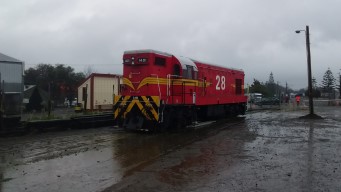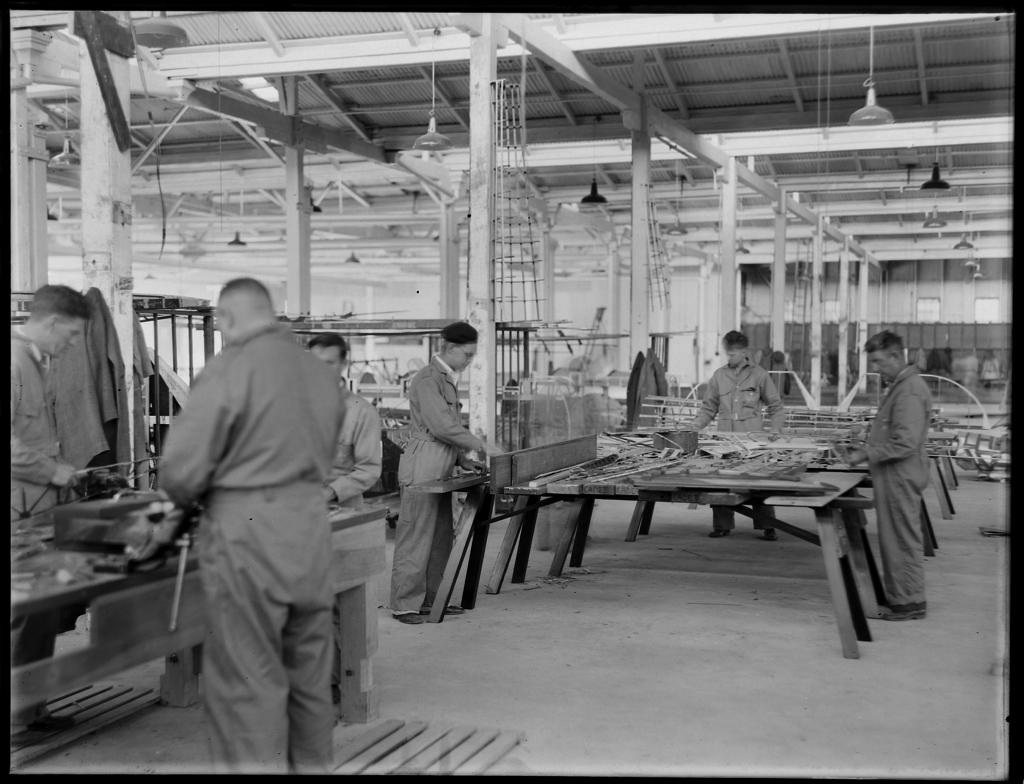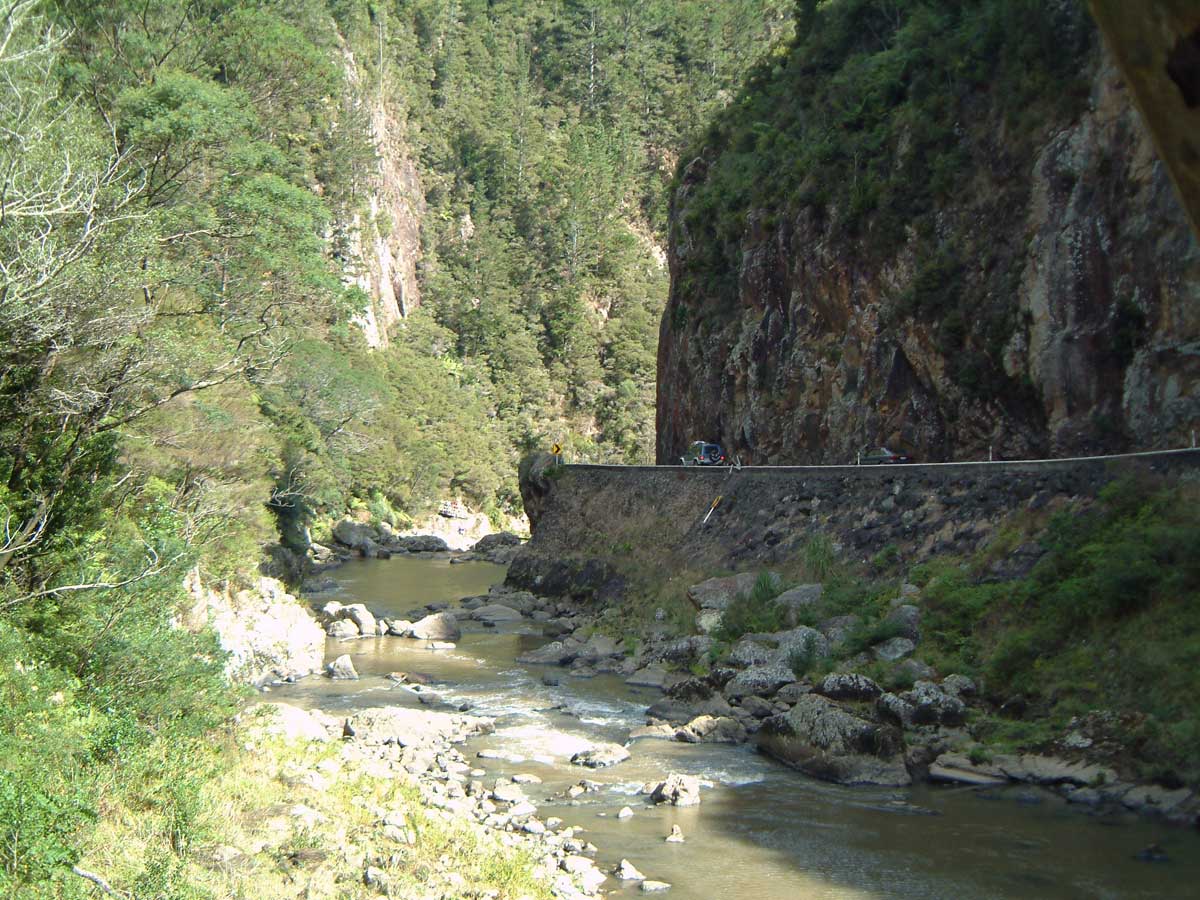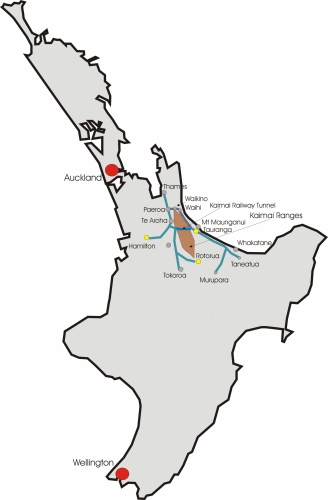|
New Zealand DB Class Locomotive
The New Zealand DB class and DBR class locomotive is a type of diesel-electric locomotive built for service on New Zealand's rail network. They were built by General Motors Diesel (GMD) of Canada as a narrow-gauge version of the EMD G8 model, with seventeen locomotives constructed. Ten of these were later rebuilt into the DBR class. Introduction The DB class was introduced to the rail network in 1965-1966 as a result of a requirement for a modern locomotive that could operate on the North Island lines that the DA class was excluded from due to their weight and axle load. They were ordered at the same time as the final DA order was placed. While these were mainly branch lines, it also applied to the East Coast Main Trunk line, particularly the section beyond Paeroa through the Karangahake and Athenree gorges until the opening of the Kaimai Tunnel in 1978. The class was virtually indistinguishable externally from the DA class, being of the same basic design and dimensions, and ... [...More Info...] [...Related Items...] OR: [Wikipedia] [Google] [Baidu] |
New Zealand DA Class Locomotive
The New Zealand DA class locomotive were a class of diesel-electric mainline locomotives operated on the New Zealand railway system between 1955 and 1989. Consisting of 146 locomotives, it was the most numerous class to ever operate in New Zealand, with five more than the AB class steam locomotive. The class were A1A-A1A versions of the Electro-Motive Diesel G12 model, with the design altered slightly to run on New Zealand's rail system, and fit the small loading gauge. They were introduced between 1955 and 1967 in three phases and were the first class of diesel locomotives to seriously displace steam traction. Between 1978 and 1983, 85 locomotives were rebuilt as the DC class, of which some are still in use. All but one of the remainder were withdrawn by 1989, with six preserved. The last locomotive was refitted for shunting duties and was rebuilt as DAR 517. Introduction The DA class have their origins in the post World War II period. Like most nations New Zealand's dom ... [...More Info...] [...Related Items...] OR: [Wikipedia] [Google] [Baidu] |
NZR DI Class
The New Zealand DI class locomotive was a class of diesel-electric locomotive in New Zealand. They were built by English Electric at their plant in Rocklea, Queensland in Australia. The class is very similar to the Queensland Railways 1620 class locomotives.The 1620 Class Diesel-electric Locomotives '' Sunshine Express'' issue 588 September 2019 page 92 At the time of their introduction, the class was seen as an alternative to the DB class for use on lightly laid secondary and branch lines, more so in the South Island. The World Bank financed introduction of the Japanese built DJ class in 1968, which ensured that no further DI class locomotives were purchased by New Zealand Railways. History The DI class were an evolution of the Queensland Railways 1600 class built by English Electric at their Rocklea, Queensland plant. The DI class featured an American-style high front hood. Queensland Railways (QR) took an interest in the NZR design and were impressed by the characteristic ... [...More Info...] [...Related Items...] OR: [Wikipedia] [Google] [Baidu] |
South Island
The South Island, also officially named , is the larger of the two major islands of New Zealand in surface area, the other being the smaller but more populous North Island. It is bordered to the north by Cook Strait, to the west by the Tasman Sea, and to the south and east by the Pacific Ocean. The South Island covers , making it the world's 12th-largest island. At low altitude, it has an oceanic climate. The South Island is shaped by the Southern Alps which run along it from north to south. They include New Zealand's highest peak, Aoraki / Mount Cook at . The high Kaikōura Ranges lie to the northeast. The east side of the island is home to the Canterbury Plains while the West Coast is famous for its rough coastlines such as Fiordland, a very high proportion of native bush and national parks, and the Fox and Franz Josef Glaciers. The main centres are Christchurch and Dunedin. The economy relies on agriculture and fishing, tourism, and general manufacturing and services. ... [...More Info...] [...Related Items...] OR: [Wikipedia] [Google] [Baidu] |
Rails (magazine)
''Rails'' was a New Zealand-based monthly periodical covering rail transport in New Zealand published by Rails Publishing Ltd from August 1971, which in 1972 changed its name to Southern Press from August 1971 until December 2003. The company was jointly owned by Bob Stott and Robin Bromby; Bob Stott was Editor and ran the editorial content and Robin Bromby was Managing Editor mainly responsible for the business operation. The editor for the entirety of ''Rails'' existence was Bob Stott QSM. Robin Bromby was managing editor from 1971 to 1975, at which time Bob and Jan Stott become the owners of the magazine. The magazine's existence spanned the final years of central government control of railways in New Zealand (the New Zealand Railways Department), corporatisation in the 1980s (the New Zealand Railways Corporation), privatisation of the railways in 1993 ( New Zealand Rail Limited, renamed Tranz Rail in 1995) and finally the purchase of Tranz Rail by Toll Holdings The Toll ... [...More Info...] [...Related Items...] OR: [Wikipedia] [Google] [Baidu] |
Clyde Engineering
Clyde Engineering was an Australian manufacturer of locomotives, rolling stock, and other industrial products. It was founded in September 1898 by a syndicate of Sydney businessmen buying the Granville factory of timber merchants Hudson Brothers. The company won contracts for railway rolling stock, a sewerage system, trams and agricultural machinery. In 1907 it won its first contract for steam locomotives for the New South Wales Government Railways. By 1923 it had 2,200 employees. After contracting during the depression it became a major supplier of munitions during World War II. In 1950 it was awarded the first of many contracts for diesel locomotives by the Commonwealth Railways after it was appointed the Australian licensee for Electro-Motive Diesel products. Apart from building locomotives and rolling stock, Clyde Engineering diversified into telephone and industrial electronic equipment, machine tools, domestic aluminium ware, road making and earth making equipmen ... [...More Info...] [...Related Items...] OR: [Wikipedia] [Google] [Baidu] |
New Zealand DC Class Locomotive
The New Zealand DC class locomotive is a type of diesel-electric mainline locomotive on the New Zealand rail network, operated by KiwiRail on freight trains, and formerly on long-distance passenger trains. The class was rebuilt from the DA class in the late 1970s and early 1980s, mainly in Australia. After the DA class, they were the most numerous class of diesel locomotive on New Zealand's railway network and remained numerically dominant until the mid-2010s when withdrawals began. History The locomotives started life as DA class, built by General Motors Canada between 1955 and 1967. Between 1978 and 1983, 85 of the later-build DAs were rebuilt. Because of a backlog of locomotives requiring heavy maintenance, Clyde Engineering were awarded a contract to rebuild 35 DA class as EMD model G22ARs, with upgraded engines, new cabs and low short hoods of a style similar to the DX class introduced earlier in the 1970s and the DF class being introduced at the time. The first few ... [...More Info...] [...Related Items...] OR: [Wikipedia] [Google] [Baidu] |
DBR 1254 At Westfield , airline ICAO code DBR
{{disambig ...
DBR may refer to: * Daniel Bernard Roumain, composer and violinist * DBR Class of diesel locomotive, New Zealand * ''De Bellis Renationis'', renaissance wargaming rules * Design-based research in the learning sciences * Deuterium bromide, chemical formula DBr * Distributed Bragg reflector, used in waveguides * Dowel bar retrofit, highway crack treatment * Drum-Buffer-Rope, in the theory of constraints * ДБР, State Bureau of Investigation (Ukraine) Codes * Bad Doberan, Germany, vehicle license plate * Derby Road (Ipswich) railway station, National Rail code DBR * DutchBird, airline ICAO code DBR * Dobrolet (low-cost airline) Dobrolet LLC (russian: ООО «Добролёт» , translit = OOO Dobrolyot) was a Russian low-cost airline - a subsidiary of Aeroflot - based at Sheremetyevo International Airport. It operated scheduled flights to domestic destinations. Hi ... [...More Info...] [...Related Items...] OR: [Wikipedia] [Google] [Baidu] |
Kaimai Tunnel
The Kaimai Tunnel is a Rail transport in New Zealand, railway tunnel through the Kaimai Range in the North Island of New Zealand. Since it was opened in 1978, it has held the title of Tunnels in New Zealand#Railway Tunnels, longest tunnel, at , in New Zealand, assuming this distinction from the previous title holder, the Rimutaka Tunnel. It is part of the Kaimai Deviation, which was constructed to bypass the old route of the East Coast Main Trunk Railway through the Karangahake Gorge (part of which has been preserved as the Goldfields Railway). History In the first half of the 20th century, the disadvantages of the East Coast Main Trunk route through the Karangahake and Athenree gorges became starkly apparent. The capacity of the line was constrained by several factors; its length, severe grades of up to 1:50, sharp curves of up to 6 chains radius, and light 55 lb per yard rail which prohibited the use of the more powerful diesel locomotives. It was also an unreliable route ... [...More Info...] [...Related Items...] OR: [Wikipedia] [Google] [Baidu] |
Karangahake Gorge
The Karangahake Gorge lies between the Coromandel and Kaimai ranges, at the southern end of the Coromandel Peninsula in New Zealand's North Island. A sharply winding canyon, it was formed by the Ohinemuri River. State Highway 2 passes through this gorge between the towns of Paeroa, Waikino and Waihi. This road is the main link between the Waikato region and the Bay of Plenty. The East Coast Main Trunk Railway used to run through the gorge until it was bypassed by the Kaimai Deviation - and the Karangahake Gorge section is now a combined walkway and cycleway, part of the Hauraki Rail Trail. There are also several walks and tracks starting at the Karangahake Reserve car park and picnic area; ranging from 30 minutes to over 2 hours. Mining The area has a strong connection to mining, and even in the 2010s, a number of companies have been prospecting and mining the area, though with much less visible and invasive methods than were used historically. The Talisman, Crown and W ... [...More Info...] [...Related Items...] OR: [Wikipedia] [Google] [Baidu] |
Paeroa
Paeroa is a town in the Hauraki District of the Waikato Region in the North Island of New Zealand. Located at the base of the Coromandel Peninsula, it is close to the junction of the Waihou River and Ohinemuri River, and is approximately 20 kilometres (12.4 miles) south of the Firth of Thames. New Zealanders know the town for its mineral springs, which in the past provided the water used in a local soft drink, "Lemon & Paeroa". The town stands at the intersection of State Highways 2 and 26, and is the central service location for the Hauraki District. The town is about half way between Auckland and Tauranga, and acts as the southern gateway to the Coromandel Peninsula, and as the western gateway to the Karangahake Gorge and the Bay of Plenty. Etymology One can gloss the Māori-language name ''Paeroa'' as composed of ''pae'' (ridge) and ''roa'' (long). Demographics Paeroa covers and had an estimated population of as of with a population density of people per km2. ... [...More Info...] [...Related Items...] OR: [Wikipedia] [Google] [Baidu] |
East Coast Main Trunk Railway
The East Coast Main Trunk (ECMT) is a railway line in the North Island of New Zealand, originally running between Hamilton and Taneatua via Tauranga, connecting the Waikato with the Bay of Plenty. The ECMT now runs between Hamilton and Kawerau, with a branch line to Taneatua from the junction at Hawkens. The line is built to narrow gauge of , the uniform gauge in New Zealand. It was known as the East Coast Main Trunk Railway until 2011, when the word "Railway" was dropped. History Construction In 1880, the North Island Main Trunk railway had reached Frankton, Waikato, Frankton, Hamilton, New Zealand, Hamilton, from Auckland. From there, it was delayed by construction of the Claudelands Bridge, original Waikato River bridge (now carrying road traffic as part of Claudelands Road), before the line made its way to Morrinsville in October 1884, Te Aroha in March 1886 and Paeroa in 1898. There were also minor delays, such as in the delivery of Podocarpus totara, totara sleepers. The ... [...More Info...] [...Related Items...] OR: [Wikipedia] [Google] [Baidu] |





